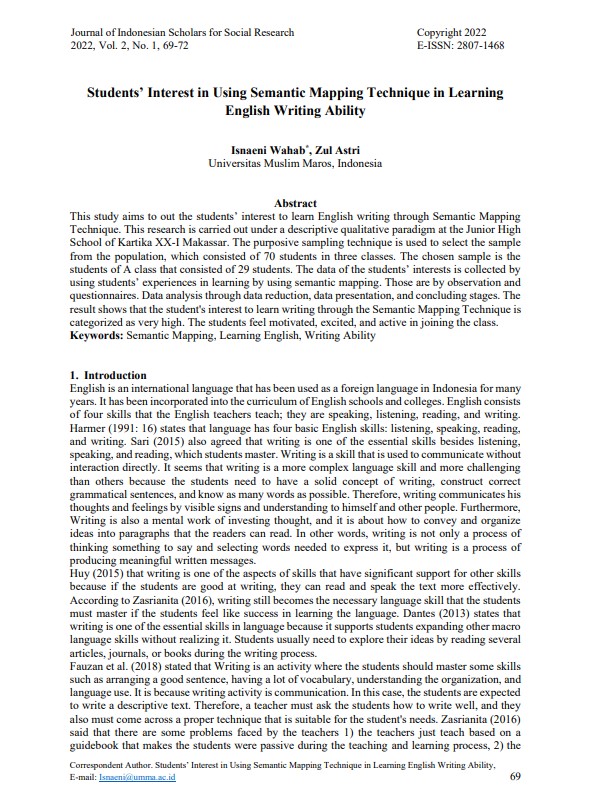Students’ Interest in Using Semantic Mapping Technique in Learning English Writing Ability
Keywords:
Semantic Mapping, Learning English, Writing AbilityAbstract
This study aims to out the students’ interest to learn English writing through Semantic Mapping Technique. This research is carried out under a descriptive qualitative paradigm at the Junior High School of Kartika XX-I Makassar. The purposive sampling technique is used to select the sample from the population, which consisted of 70 students in three classes. The chosen sample is the students of A class that consisted of 29 students. The data of the students’ interests is collected by using students’ experiences in learning by using semantic mapping. Those are by observation and questionnaires. Data analysis through data reduction, data presentation, and concluding stages. The result shows that the student's interest to learn writing through the Semantic Mapping Technique is categorized as very high. The students feel motivated, excited, and active in joining the class.
Keywords: Semantic Mapping, Learning English, Writing Ability
Downloads
References
Buzan, T. (2000). The Mind Map Book. Penguin Books.
Dantes, N. (2012). Metode Penelitian. Yogyakarta: C.V Andi Offset.
Fauzan, A., Jufrizal., Zul Amri. (2018) The Effect of Semantic Mapping in Teaching Writing Skill on Seventh Grade Students of SMPN 3 Batusangkar. Advances in Social Science, Education and Humanities Research, V (301)
Harmer, J. (2007).How to teach for exams (3rd ed.). Edinburg: Pearson Education Limited.
Harmer, J. 1991. The Practice of English Language Teaching. New York: Longman Group
Huy, N.T. 2015. Problem Affectivity Learning Writing Skill of Grade II at Thony LinhHight School.Asian Journal of Educational Research.Vol. 3, No 2.
Indah, O. D., & Crestiana, J. (2022). Analyzing the Students’ Interest on the Use of Semantic Mapping Strategy in Improving Students Writing Skill. IDEAS: Journal on English Language Teaching and Learning, Linguistics and Literature, [S.l.], Vol 9 (2), p. 825-833, https://ejournal.iainpalopo.ac.id/index.php/ideas/article/view/2401
Johnson, P A. (2008). Teaching Reading and Writing. United States of America: Rowman & Littlefield Publisher, Inc
Nurhaeni. (2014). The Implementation of Semantic Mapping Technique in Teaching Descriptive Text to Improve Students’ Writing Ability of the Eighth Graders of SMPN 3 Bontoramba Kab. Jeneponto. Thesis UNM
Purwanto. (2019). Improving Writing Recount Texts through Semantic Mapping. Teacher in educational Research. Vol 1(2) p. 76-90 https://ejournal.ressi.id/index.php/TER/article/view/48/76
Sari, N. P. (2015). Improving Students’ Writing Skills in Narrative Text by Using Semantic Mapping. Jurnal Edutama Vol. 2 No. 1
Sugiyono, (2017). Metode Penelitian Pendidikan (Pendekatan Kuantitatif, Kualitatif, dan R&D). Bandung: Alfabeta
Zaid, M. A. 1995. Semantic Mapping in Communicative Language Teaching. English Teaching Forum 33 (3), 6-16. Retrieved on December 15th 2013 http://exchanges.go.com
Zasrianita, F. (2016). Applying Semantic Mapping Technique in Students’ Writing Quality. Jurnal Bahasa. Vol 6 (2) https://ejournal.iainbengkulu.ac.id/index.php/alughah/article/view/1486 http://dx.doi.org/10.29300/lughah.v6i2.1486

Downloads
Published
How to Cite
Issue
Section
License
Copyright (c) 2022 Journal of Indonesian Scholars for Social Research

This work is licensed under a Creative Commons Attribution-ShareAlike 4.0 International License.
Authors who publish in this journal agree to the following conditions:
- Authors retain the copyright of their work while granting the journal the right of first publication. The published work is licensed under the Attribution-ShareAlike 4.0 International (CC BY-SA 4.0) license (https://creativecommons.org/licenses/by-sa/4.0/). This license permits others to share and adapt the work, provided that proper credit is given to the original author(s) and the journal as the initial publisher.
- Authors may establish separate, additional agreements for the non-exclusive distribution of their published work (e.g., depositing it in an institutional repository or including it in a book), as long as they acknowledge its original publication in this journal.
- Authors must sign a copyright transfer agreement once they have reviewed and approved the final proof provided by JISSR before publication.









